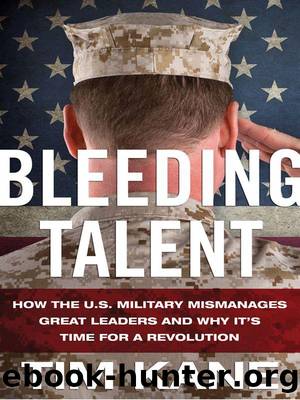Bleeding Talent: How the US Military Mismanages Great Leaders and Why It's Time for a Revolution by Tim Kane

Author:Tim Kane [Kane, Tim]
Language: eng
Format: epub
Publisher: Palgrave Macmillan
Published: 2012-12-11T10:00:00+00:00
THE TOTAL VOLUNTEER FORCE
Real change requires us to sacrifice at least one sacred cow. We might begin by facing up to the fact that many of the military’s espoused values are simply not those in practice with the current HR structure. Specifically, what if the mantra “the needs of the army come first” is actually wrong? That mantra is used to justify actions that displease the individual in order to serve the theoretical greater good. But if we boil it down to fundamentals, what theory says the greater good is being served when an individual is coerced to do something? The needs of the army previously justified conscription, a system we now recognize as detrimental to the army, so maybe the mantra actually encourages short-term solutions. What if we let the needs of the army come second?
The moral case for markets was argued long ago by Adam Smith in the Wealth of Nations. Markets look mercenary to moralizers, which is why Smith had to explain the efficiency gains as if they were from an (godly) invisible hand even when the agents in the market were acting purely in self-interest. Smith essentially argued to let the needs of the community come second. A self-interested labor market enables American companies and entrepreneurs to create the biggest, richest, most productive economy the world has ever seen. A similar market would enable an even stronger US military. Self-interested, spontaneous order is counterintuitive to some, but it happens to be that kind of liberty that the US military exists to protect.
Coercion is the key word to keep in mind when pondering what ails HR management. Coercion offends strong men and women and belittles their intelligence. And it was the coercion of young citizens to serve in uniform that defined the philosophy of conscription. When Richard Nixon promised to end the draft during the 1968 presidential campaign, he was opposed by many conservatives and even more liberals, but he was embraced by the young. He was also embraced by free-market economists who promised that a market for labor could work, that a supply of volunteer professional soldiers would come forward to replace the involuntary citizen soldiers. Economists such as Milton Friedman and Walter Oi promised that supply would meet demand. When President Nixon made good on the promise and implemented the all-volunteer force (AVF) in 1973, it was a revolutionary movement, culturally and managerially. It worked.
I’d like to think the AVF provides a model of the kind of revolutionary change that the military can take now in moving one step further in the same direction, away from coercion and toward free labor markets. Understanding what that next step will be requires that we look at the limitations of the AVF. Contrary to its name, the AVF is not exactly all volunteers, or at least not all the time. A better name is probably the “first-day volunteer force,” because after men and women take their oath of office on the first day in uniform, the volunteerism ends.
If
Download
This site does not store any files on its server. We only index and link to content provided by other sites. Please contact the content providers to delete copyright contents if any and email us, we'll remove relevant links or contents immediately.
International Integration of the Brazilian Economy by Elias C. Grivoyannis(99270)
The Radium Girls by Kate Moore(11977)
Turbulence by E. J. Noyes(7983)
Nudge - Improving Decisions about Health, Wealth, and Happiness by Thaler Sunstein(7660)
The Black Swan by Nassim Nicholas Taleb(7063)
Rich Dad Poor Dad by Robert T. Kiyosaki(6517)
Pioneering Portfolio Management by David F. Swensen(6261)
Man-made Catastrophes and Risk Information Concealment by Dmitry Chernov & Didier Sornette(5958)
Zero to One by Peter Thiel(5736)
Secrecy World by Jake Bernstein(4703)
Millionaire: The Philanderer, Gambler, and Duelist Who Invented Modern Finance by Janet Gleeson(4425)
The Age of Surveillance Capitalism by Shoshana Zuboff(4252)
Skin in the Game by Nassim Nicholas Taleb(4206)
Bullshit Jobs by David Graeber(4143)
The Money Culture by Michael Lewis(4138)
Skin in the Game: Hidden Asymmetries in Daily Life by Nassim Nicholas Taleb(3962)
The Dhandho Investor by Mohnish Pabrai(3729)
The Wisdom of Finance by Mihir Desai(3698)
Blockchain Basics by Daniel Drescher(3544)
